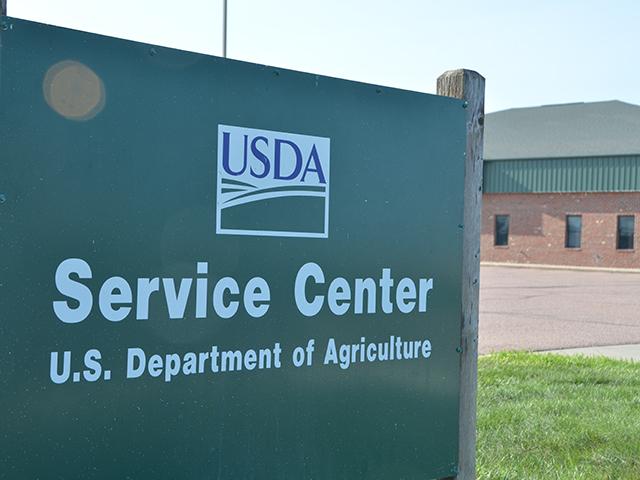Thune Presses for FSA Offices to Reopen
Marketing Assistance Loans Could Provide a Cash Flow Option When FSA Offices Reopen
OMAHA (DTN) -- Senate Majority Leader John Thune has been trying to convince the Trump administration to reopen Farm Service Agency offices around the country so farmers can tap into commodity loans during harvest, Politico reported Thursday.
Congress remains gridlocked after the Senate again failed Thursday to pass a short-term spending bill that would reopen the federal government.
Politico reported that Thune, a Republican from South Dakota, has been "relentlessly" pressing the White House to reopen FSA offices. One of the big challenges, however, is that the Commodity Credit Corp. (CCC) fund also needs to be replenished.
More than 2,100 USDA Service Centers remain closed during the shutdown. That has locked farmers out of Agricultural Risk Coverage/Price Loss Coverage (ARC/PLC) payments as well as access to Marketing Assistance Loans (MALs). Based on MAL usage, that is likely affecting farmers of some commodity crops more than others.
Politico noted that currently, administration officials have no plan to shift money around to allow farmers to tap into marketing loans while the government is shut down.
Agriculture Secretary Brooke Rollins, speaking on Fox Business Network on Thursday, repeated comments she had made last week, suggesting a potential aid package for farmers is coming. "As soon as the shutdown lifts, we'll be ready to roll something out, and really looking at those who are harmed under the current trade negotiations because China is not abiding by their deal."
MAL UPSIDE: CHEAP LIQUIDITY
A commodity loan can provide some market flexibility and some quick liquidity -- if a producer has a way to store their grain.
This could make MALs more useful this year, as farm-finance experts have already highlighted that farmers will face cash flow problems. Producers who used alternative financing could also face earlier demands to repay their operating loans.
Chris Gibbs, an Ohio farmer and president of Rural Voices USA, told DTN last week in an interview that he plans to get a commodity loan at his local FSA office once it reopened.
"A Marketing Assistance Loan is a low-interest loan. It's 5%, but it's lower than anything else you are going to get," Gibbs said.
P[L1] D[0x0] M[300x250] OOP[F] ADUNIT[] T[]
As of September, the MAL interest rate was 5%, which is set at 1% above the CCC borrowing rate and is a fixed rate.
Gibbs said he will store his corn and soybeans and use the commodity loan to pay off an operating loan that has nearly a 3-percentage-point higher interest rate. Ideally, within the nine-month loan term, there will also be a price rally.
"At least it gives you some cash flow to pay some fall bills and maybe even purchase some 2026 supplies if you can find them and you can afford them. Of course, the FSA office has to be open," he said.
Gibbs added, "I don't understand why more people don't use it ... It's a gift for cash flow. Even if you don't have any outstanding debt or anything, if you can save 10% to 20% on buying your seed corn in November or December, you just borrow from the government at 5% and save 'x' amount of dollars. It's an absolute no-brainer."
MAL DOWNSIDE: LOW COMMODITY RATES
Generally, few corn, soybean and wheat farmers bother using MALs, according to USDA data. USDA's published national prices are at $2.20 a bushel for corn, $6.20 a bushel for soybeans and $3.38 a bushel for wheat.
Those prices are considered low, but there is another layer on top of that because counties also have different loan rates tied more to local basis and markets. In McLean County, Illinois, for instance, the loan rates are $2.25 for corn and $6.34 for soybeans. In Kossuth County, Iowa, the corn loan rate is $2.10 while the rate for soybeans is $6.15.
Using the $2.20 national corn price, a farmer putting 50,000 bushels under a MAL would get a $110,000 loan at 5% interest for nine months.
USDA commodity loan activity shows fewer than 505 million bushels of corn were put under a commodity loan last year -- just about 3.4% of the total corn crop. Only 2% of the 2024 soybean crop was put under MAL, and just over 1% of the wheat crop was under a commodity loan.
Producers of other crops use commodity loans far more heavily, and it is often a standard marketing practice. More than 7.7 million bales of upland cotton were put under a loan last year; 2.27 billion pounds of sugarbeets went under a MAL; and nearly 4.9 billion pounds of peanuts were placed under MALs.
REQUIREMENTS FOR A MAL
To take out a commodity loan, a producer must have "beneficial interest" in the grain, either storing it on-farm or at an elevator.
A producer's crop must be certified, including filing an acreage report at FSA and signing a "Storage and Security Agreement," or, if the grain is stored at a commercial elevator, providing the warehouse receipts.
MALs are not subject to payment limits since they are loans, not subsidies. However, if the market price falls below the loan rate, a producer could end up forfeiting the grain to the CCC.
REOPEN FSA DURING A SHUTDOWN?
It happened in 2019. Then-Agriculture Secretary Sonny Perdue reopened FSA offices one week before the actual government shutdown ended. Perdue called back FSA state employees specifically to help producers who were dealing with existing loans to release proceeds from the sale of loan security by signing checks. However, FSA staff at that time were not allowed to help producers with new loans or other programs until the government reopened.
USDA in 2019 also had to extend application deadlines for multiple programs -- including the 2019 trade aid program -- after the government reopened.
For more, see "Farmers Become a Messaging Focal Point Amid Shutdown and Trade Turmoil" here: https://www.dtnpf.com/….
Also see "Ag Economy Under Pressure: A Farmer Vents and High-Level Blame: Frustration Over Ag Economy Boiling Over in Social Media and White House" here: https://www.dtnpf.com/….
And see "AFBF President: Conditions Are Becoming Too Much For Family Farms to Bear" here: https://www.dtnpf.com/….
Chris Clayton can be reached at Chris.Clayton@dtn.com
Follow him on social platform X @ChrisClaytonDTN
(c) Copyright 2025 DTN, LLC. All rights reserved.




